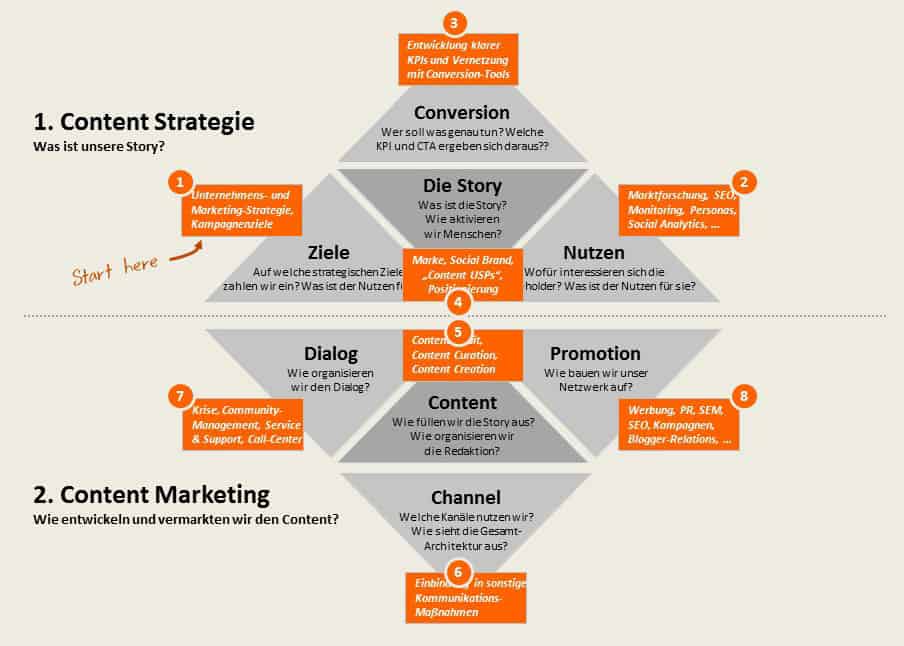How smart companies develop content marketing strategies - Part 1: The strategic basis
We want to explain to you step by step how to develop a "content strategy" in a short series of articles. The idea is that you always give your audience exactly the information that they find desirable and helpful at that particular moment, in exactly the formats that best convey the messages and via the channels that are suitable for the respective content and target groups. Quite simply. So to speak. And today, in the first part of the series, we're talking about the "strategic basis".

1. your own goals
At the very beginning of every strategy are its goals. This has always been the case, and it hasn't changed in the age of content marketing. Yes, you have to offer benefits for the reader, "added value". Yes, you also need to think a bit like a publisher, as is always said, i.e. offer good editorial content. And yes, you also need to carry out a "content audit" as part of your content strategy.
However, you don't do this at the beginning, but only after the "strategic basis". Because without a strategic basis, you can't evaluate the content in the content audit - why should you? Because at the end of the day, you have to create value for your company! You work in or for a company or organization. And your job is to make this company or organization more successful!
The content audit is not at the beginning of a content strategy - but at the end
Mirko Lange
- Pick out the goals that you want to support with content from the corporate, marketing, PR or other strategies. For example: "Gain trust". The closer your content strategy is to the goals of your colleagues and your company, the greater the acceptance of what you are doing will be. However, it is difficult with the goal of "increasing sales". Because direct "sales promotion" is very difficult to achieve with "content". You then have to consider what other goals are suitable for promoting these sales, e.g. "competence leadership" if you are a consulting company. And although it is called "content marketing", these objectives do not necessarily have to come from marketing. They can also come from corporate communications (e.g. "crisis resistance") or from the HR department (e.g. "getting more qualified applicants"). The important thing is that you make it clear that you are helping your colleagues to do their job better!
- Make a list out of it. A list of all the points that you want to contribute to with your content. Write the following explicitly in your strategy: "Content marketing should contribute to strengthening our company's resistance to crises". Or "Content marketing should contribute to our company being perceived as a competence leader". Or "Content marketing should contribute to our company being perceived as a service leader."
- Think about what you can and must achieve specifically through communication so that you can actually achieve these strategic goals. For "crisis resistance", for example, this could be "providing information" or "creating transparency". For "service leadership", this could be "solving problems". Or for "competence leadership": "share know-how". You will notice that some communicative tasks serve several purposes. And that's a good thing.
- Pick up on these two points later during editorial planning. For each piece of content, define the objective to which this content should contribute and the communication task it should fulfill. Two or three keywords are sufficient, e.g. "crisis resistance" and "create transparency". The rule is simple: if you cannot define a value for a post or article planned for later: Don't write it! It is then literally worthless. This is how you "operationalize" your content strategy later and use it in your operational business. It then has a guiding and leadership function.
2. the added value for the public
Just as important as defining your own goals is defining the added value for the reader. It's almost a truism: no matter what you read about content marketing, it's always said that you need to create "useful content" or "editorial content". But how do you really do that? The key is to put yourself in the other person's shoes. In other words, no longer looking from "your own eyes", but from the perspective of the prospective customer. And there are certainly methods for doing this:
- First, define who the people are that you want to reach. You will initially do this via target and stakeholder groups. It is also important here that you pick up on the terms used in the strategies of your colleagues, i.e. in marketing, PR or HR. Here too, the more you make it clear to your colleagues that you are helping them with their work, the greater the acceptance and support will be.
- Then define "personas". A "persona" is a typical, concrete person who is representative of comparable types. Create a very specific profile with your colleagues from marketing, market research, sales or support: give the persona a name, find a picture for the persona from a picture agency, define their specific "pain points" in relation to each other, i.e. their problems. Also define the motivations, i.e. what drives the persona. The more concrete this "profile" is, the better. It is best to imagine a real person that you know. Pick out the prototypical customers. The more you bring in from practice, the better. Describing someone only theoretically is useless. And don't create too many personas. 5 to 6 are completely sufficient. The important thing here is not scientific accuracy, but rather that you start to change your perspective. And to put it bluntly: anything else is better than looking through your egocentric glasses. Because you have already done that in step 1.
Personas are not a science. If you take a look from a different perspective, that's enough.
Mirko Lange
- Create a list of the possible benefits you want to create for these personas: So, for example, "entertainment" or "problem solving" or "orientation" or "inspiration". Think about what your specific "gift" is for this persona. It is also very helpful to ask whether this persona would theoretically be willing to pay money for your content. Also consider the so-called "customer journey", i.e. the phases that a prospective customer typically goes through in order to decide in favor of you or your product. This should be quite simple for toilet paper, but in the B2B sector and for an investment product, it can take a few steps. Talk to your sales or marketing department about this.
- Use both lists later for editorial planning, i.e. the one with the personas and the one with the specific benefit. The same applies here: if a piece of content does not provide a very specific benefit for a very specific persona, then it is worthless. Then you should do without it.
- And use the problems for the topic definition later on. We will come to this in one of the next steps.
3. the conversion
As the saying goes: "There is nothing good unless you do it". And that's what this is all about. The third part of our strategic basis is to define what your personas should do (!). This is where we move from strategic goals to operational goals. And the joke is: they are all measurable! This is another reason why we focus on "doing". Because that is visible. Nobody can see or measure what someone thinks, or wishes for, or has for an attitude. And they are all irrelevant - unless they result in concrete actions.
- Take your personas again and make a list of what you want them to do specifically: The list of possible points is endless! But be specific: "Sign up for the newsletter" could be one point. Or: "Comment" (that was short and simple). But also "like". Even "click" is a very good goal, but here you should make sure that you have a defined "call-to-action" that prompts people to click somewhere.
- It is important that you compare this list with the objectives from point one. Does this action contribute to a strategic goal? This is the filter so that you do not define arbitrary actions. The same applies here: anything that does not contribute to the strategic goal is worth nothing. For example, you can also justify the value of a "Like". Because a Like can certainly help you to be perceived as a competence leader. This is certainly not a major contribution (the substance of your content is more important), but it is a contribution. This is because people generally treat specialists with a large number of followers with greater respect.
- Now you can add a "KPI", a "key performance indicator", to every action. Well, to be precise: The action IS already the key performance indicator. Because getting people to do something is precisely the "performance", that is the achievement and goal of communication. And we ensured that this is also a "key" in the second point: Because we have checked whether this action helps us to achieve a strategic goal. What we really need to do now, however, is to determine the metric. But since we have defined actions, this is not difficult at all. Newsletter subscriptions can be counted. Comments too. And also likes.
- And last but not least, you also need to determine target values for these KPIs. If you are just starting out with your strategy and do not yet have a basis, this is difficult. Don't set any target values yet, even if everyone always says that you should define targets precisely. That's true, but it shouldn't lead to you simply guessing. So start with a so-called "zero measurement", e.g. by recording these values for a month. And then set yourself targets, e.g. to increase these values by an average of 10 percent every month.
So, those were the first three steps. We only have 9 more to go until we've completed the dozen. But don't despair! And the next tip is about how we can condense the first three points into a "story". It will be the central point of our strategy. Until then, we hope you enjoy implementing it.






